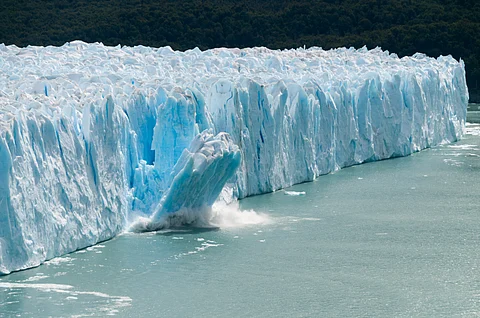

Glaciers lost an estimated 273 billion tonnes of ice annually from 2000 to 2023, making them the second-largest contributor to rising sea levels, according to a new study.
The total global glacier mass loss over this period amounts to 6.54 trillion tonnes, contributing 18 millimetres (mm) to global sea-level rise. The annual rate of sea-level rise attributed to glacier melt was 0.75 mm per year, the study, published in the journal Nature, noted.
Furthermore, ice loss accelerated significantly in the second half of the study period (2012-2023), increasing by 36 per cent compared to the first half (2000-2011).
“Our observations and recent modelling studies indicate that glacier mass loss will continue and possibly accelerate until the end of this century,” Samuel Nussbaumer, a glaciologist at the University of Zurich (UZH), said in a statement.
“This underpins the Intergovernmental Panel on Climate Change’s (IPCC) call for urgent and concrete actions to reduce greenhouse gas emissions and associated warming to limit the impact of glacier wastage on local geohazards, regional freshwater availability, and global sea-level rise,” he added.
Glaciers, distinct from the continental ice sheets in Greenland and Antarctica, covered approximately 706,000 square kilometres globally around the year 2000. Their melting exacerbates local geohazards, impacts marine and terrestrial ecosystems and threatens regional freshwater resources, while also influencing global water and energy cycles.
To map the changing glaciers, an international team of scientists conducted the Glacier Mass Balance Intercomparison Exercise (GlaMBIE), an initiative aimed at providing a reconciled assessment of global glacier mass changes for the next IPCC report.
Researchers used different field and satellite observation methods to collect, homogenise, combine, and analyse glacier mass change. They employed a range of field and satellite observation methods to collect, standardise, combine and analyse data on glacier mass changes.
“We have got a wealth of satellite observations since 2000. While this allowed us to observe mass changes from all the about 275,000 glaciers worldwide, the results published did often not well agree, came with large uncertainties, or were not directly comparable due to different regional or temporal coverage,” Michael Zemp, professor at the Department of Geography at UZH, told Down To Earth.
To address this issue, the team conducted an intercomparison study, bringing together experts and data from key observation methods. This enabled them to compare and combine results from different techniques into an annual time series of glacier mass changes for all glacier regions worldwide from 2000 to 2023.
Their analysis revealed that glaciers have lost between 2 per cent and 39 per cent of their ice regionally and approximately 5 per cent globally.
Additionally, glacier mass loss was found to be around 18 per cent greater than that of the Greenland Ice Sheet (the largest ice mass in the Northern Hemisphere) and more than twice that of the Antarctic Ice Sheet (the largest ice mass on Earth). The ice sheets of Greenland and Antarctica together store about two-thirds of the world’s freshwater, according to United States’ National Aeronautics and Space Administration.
The loss has been particularly pronounced in recent years, with the period from 2019 to 2023 witnessing the highest annual ice loss — exceeding 400 gigatonnes per year (Gt/yr) — including a record 548 Gt/yr in 2023.
The largest regional contributors to global glacier mass loss were Alaska (22 per cent), the Canadian Arctic (20 per cent), peripheral glaciers in Greenland (13 per cent) and the Southern Andes (10 per cent).
Glacier size also influenced mass loss, with the greatest relative ice loss occurring in regions where glaciers covered 15,000 square kilometres or less.
Zemp explained that the study underscored the primary contributors to the observed global mean sea-level rise of 3.6 mm per year between 2003 and 2016. The steric component — changes in ocean temperature and salinity — accounted for 33 per cent, followed by glaciers at 20 per cent and the Greenland Ice Sheet at 17 per cent.
“Smaller contributions originate from changes in land water storage and the Antarctic Ice Sheet. In view of their increasing melting, glaciers will be a main driver of sea-level rise over the coming decades. On the longer term, the ice sheets in Greenland and Antarctica will dominate sea-level rise,” he added.
The researchers emphasised that glaciers are crucial freshwater resources, particularly for communities in Central Asia and the Central Andes, where glacier meltwater sustains rivers during warm and dry seasons.
“But when it comes to sea-level rise, the Arctic and Antarctic regions with their much larger glacier areas are the key players. Almost one quarter of the glacier contribution to sea-level rise originates from Alaska,” UZH glaciologist Inés Dussaillant, who was involved in the GlaMBIE analyses, said in a statement.